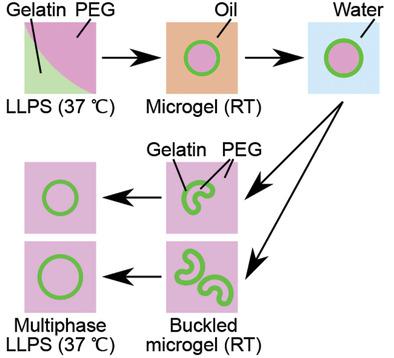当前位置:
X-MOL 学术
›
Adv. Mater. Interfaces
›
论文详情
Our official English website, www.x-mol.net, welcomes your feedback! (Note: you will need to create a separate account there.)
Deformable and Robust Core–Shell Protein Microcapsules Templated by Liquid–Liquid Phase-Separated Microdroplets
Advanced Materials Interfaces ( IF 5.4 ) Pub Date : 2021-09-13 , DOI: 10.1002/admi.202101071 Yufan Xu 1 , Yi Shen 1, 2, 3 , Thomas C. T. Michaels 1, 4 , Kevin N. Baumann 1, 5 , Daniele Vigolo 3, 6, 7 , Quentin Peter 1 , Yuqian Lu 1 , Kadi L. Saar 1 , Dominic Vella 8 , Hongjia Zhu 1 , Bing Li 1 , He Yang 1, 9 , Alexander P. M. Guttenplan 1, 10 , Marc Rodriguez‐Garcia 1 , David Klenerman 1 , Tuomas P. J. Knowles 1, 5
Advanced Materials Interfaces ( IF 5.4 ) Pub Date : 2021-09-13 , DOI: 10.1002/admi.202101071 Yufan Xu 1 , Yi Shen 1, 2, 3 , Thomas C. T. Michaels 1, 4 , Kevin N. Baumann 1, 5 , Daniele Vigolo 3, 6, 7 , Quentin Peter 1 , Yuqian Lu 1 , Kadi L. Saar 1 , Dominic Vella 8 , Hongjia Zhu 1 , Bing Li 1 , He Yang 1, 9 , Alexander P. M. Guttenplan 1, 10 , Marc Rodriguez‐Garcia 1 , David Klenerman 1 , Tuomas P. J. Knowles 1, 5
Affiliation

|
Microcapsules are a key class of microscale materials with applications in areas ranging from personal care to biomedicine, and with increasing potential to act as extracellular matrix (ECM) models of hollow organs, tissues, or biomolecular condensates. Such capsules are conventionally generated from non-ECM materials including synthetic polymers. Here, robust microcapsules with controllable shell thickness from physically- and enzymatically-crosslinked gelatin are fabricated, and a core–shell architecture is achieved by exploiting a liquid–liquid phase-separated aqueous system in a one-step microfluidic process. Microfluidic mechanical testing reveals that the mechanical robustness of thicker-shell capsules could be controlled through modulation of the shell thickness. Furthermore, the microcapsules demonstrate environmentally-responsive deformation, including buckling driven by osmosis and external mechanical forces. A sequential release of cargo species is obtained through the degradation of the capsules. Stability measurements show the capsules are stable at 37 °C for more than 2 weeks. Finally, through gel–sol transition, microgels function as precursors for the formation of all-aqueous liquid–liquid phase-separated systems that are two-phase or multiphase. These smart capsules that can undergo phase transition are promising models of hollow biostructures, microscale drug carriers, and building blocks or compartments for active soft materials and robots.
中文翻译:

液-液相分离微滴模板化的可变形且坚固的核-壳蛋白微胶囊
微胶囊是一类关键的微尺度材料,其应用范围从个人护理到生物医学,并且越来越有可能用作中空器官、组织或生物分子凝聚物的细胞外基质 (ECM) 模型。这种胶囊通常由包括合成聚合物在内的非 ECM 材料制成。在这里,通过物理和酶促交联的明胶制造了具有可控壳厚度的坚固微胶囊,并通过在一步微流体过程中利用液-液相分离的水性体系实现了核-壳结构。微流体力学测试表明,可以通过调节壳厚度来控制较厚壳胶囊的机械强度。此外,微胶囊表现出环境响应变形,包括由渗透和外部机械力驱动的屈曲。通过胶囊的降解获得货物种类的顺序释放。稳定性测量显示胶囊在 37°C 下可稳定超过 2 周。最后,通过凝胶-溶胶转变,微凝胶作为形成两相或多相全水液-液相分离系统的前体。这些可以进行相变的智能胶囊是中空生物结构、微型药物载体以及用于活性软材料和机器人的构建块或隔室的有前途的模型。稳定性测量显示胶囊在 37°C 下可稳定超过 2 周。最后,通过凝胶-溶胶转变,微凝胶作为形成两相或多相全水液-液相分离系统的前体。这些可以进行相变的智能胶囊是中空生物结构、微型药物载体以及用于活性软材料和机器人的构建块或隔室的有前途的模型。稳定性测量显示胶囊在 37°C 下可稳定超过 2 周。最后,通过凝胶-溶胶转变,微凝胶作为形成两相或多相全水液-液相分离系统的前体。这些可以进行相变的智能胶囊是中空生物结构、微型药物载体以及用于活性软材料和机器人的构建块或隔室的有前途的模型。
更新日期:2021-10-08
中文翻译:

液-液相分离微滴模板化的可变形且坚固的核-壳蛋白微胶囊
微胶囊是一类关键的微尺度材料,其应用范围从个人护理到生物医学,并且越来越有可能用作中空器官、组织或生物分子凝聚物的细胞外基质 (ECM) 模型。这种胶囊通常由包括合成聚合物在内的非 ECM 材料制成。在这里,通过物理和酶促交联的明胶制造了具有可控壳厚度的坚固微胶囊,并通过在一步微流体过程中利用液-液相分离的水性体系实现了核-壳结构。微流体力学测试表明,可以通过调节壳厚度来控制较厚壳胶囊的机械强度。此外,微胶囊表现出环境响应变形,包括由渗透和外部机械力驱动的屈曲。通过胶囊的降解获得货物种类的顺序释放。稳定性测量显示胶囊在 37°C 下可稳定超过 2 周。最后,通过凝胶-溶胶转变,微凝胶作为形成两相或多相全水液-液相分离系统的前体。这些可以进行相变的智能胶囊是中空生物结构、微型药物载体以及用于活性软材料和机器人的构建块或隔室的有前途的模型。稳定性测量显示胶囊在 37°C 下可稳定超过 2 周。最后,通过凝胶-溶胶转变,微凝胶作为形成两相或多相全水液-液相分离系统的前体。这些可以进行相变的智能胶囊是中空生物结构、微型药物载体以及用于活性软材料和机器人的构建块或隔室的有前途的模型。稳定性测量显示胶囊在 37°C 下可稳定超过 2 周。最后,通过凝胶-溶胶转变,微凝胶作为形成两相或多相全水液-液相分离系统的前体。这些可以进行相变的智能胶囊是中空生物结构、微型药物载体以及用于活性软材料和机器人的构建块或隔室的有前途的模型。


























 京公网安备 11010802027423号
京公网安备 11010802027423号